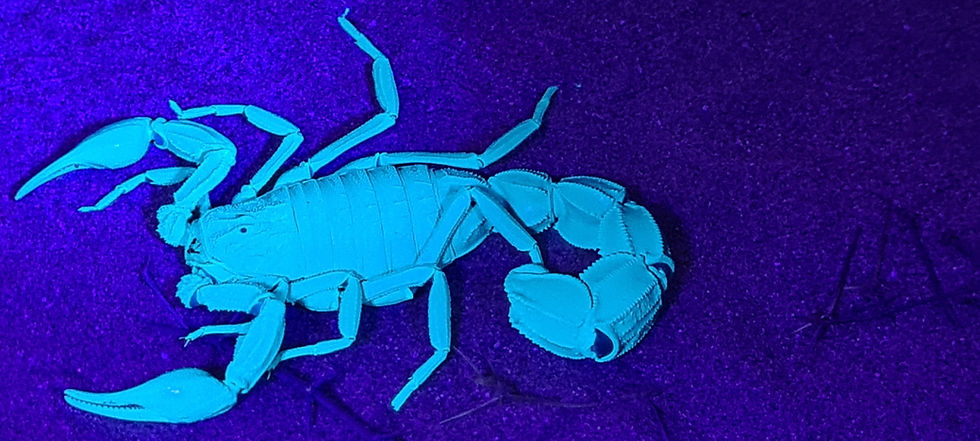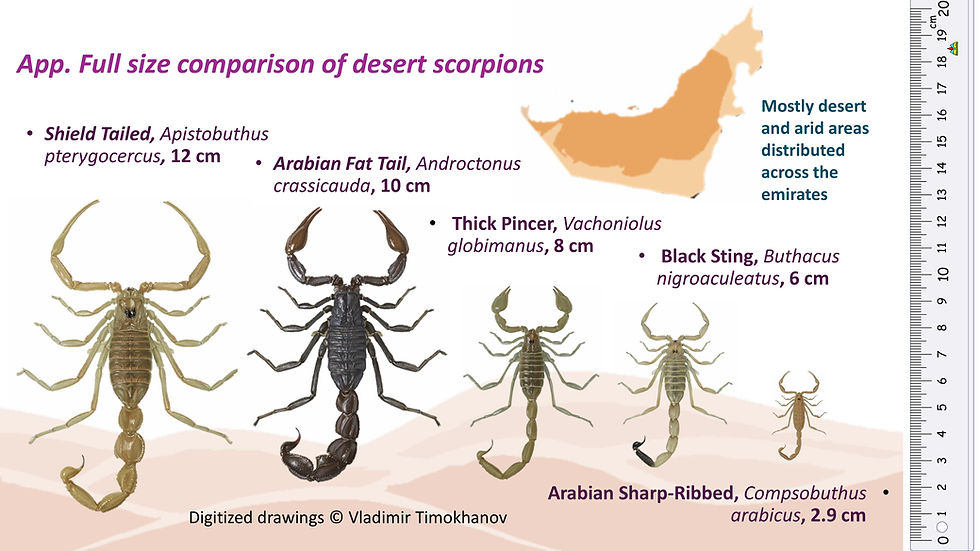Scorpions: Stingers of the Lowland Sands and High Wadis
- Mattar Al Muhairy

- Jul 23
- 6 min read
Updated: Aug 28
Of all arachnids, scorpions are the most feared and fascinating. Coming in different shapes, sizes, and toxicity levels, they have survived, adapted, and spread across the globe since their ancestors first appeared more than 400 million years ago. In ancient societies, they were feared as gods, demons, and deadly nuisances, but they have since proven their worth as agricultural pest control agents, medically important research subjects, and even exotic pets. Most scorpions in the UAE belong to the family Buthidae. Buthids have pear- or teardrop-shaped bodies with diverse claw and tail sizes. In contrast, the members of the subfamily Scorpioninae are mostly uniform in shape, with a cucumber-shaped body, thick claws, and thin tails. They are represented in the UAE by two families, Hemioscorpidae (genus Hemioscorpius) and Diplocentridae (genus Nebo). The genus Scorpio of the family Scorpionidae is considered the least toxic in the Gulf, with two species recorded in Qatar but not yet verified in the UAE, which requires further investigation. It is essential to recognize that the dimensions of claws and tails are not reliable indicators of threat levels. Instead, a comprehensive understanding of local species is more beneficial in this context.

Most Arabian species are considered of general toxicity; hence, campers, hikers, and farmers are advised to approach them with adequate knowledge, care, and respect. Three genera, namely Androctonus, Leiurus, and Hemiscorpius, are recognized as among the most lethal in the world, with documented fatalities associated with them. The Arabian fat-tailed scorpion, with its scientific name Androctonus crassicauda (Family Buthidae), is commonly found throughout the UAE and is renowned for its highly potent venom. The rough translation of the Latin name Androctonus is literally man killer. Another regional icon commonly the is the deathstalker (Leiurus quinquestriatus) which has recently been split into multiple species across the Middle East and now confined to North Africa. However previous records of its sightings in the UAE may precisely be that of the recently described Arabian Deathstalker (Leiurus Arabicus) and further research to verify this will be important in the coming years. Among the lesser-known species, notably the most challenging to treat medically, are those belonging to the Hemiscorpius genus, commonly referred to as "gadim” or “qadim” scorpions, a term meaning “ancient” in Persian and Arabic. This genus is represented so far in the Eastern emirates by two species: Hemiscorpius arabicus and the recently described Hemiscorpius flagelliraptor, with possibly more species awaiting discovery along the Hajar mountain range. Unlike most species which rely on painful, fast-acting neurotoxins, Hemiscorpius venom is a painless, slow-acting cytotoxin that can lead to tissue damage and delayed symptoms. Currently, antivenom is not available for this genus; however, progress is being made in its development in various countries. The populations most at risk of scorpion envenomation include farmers, campers, construction workers, wildlife conservationists, military personnel, children, and the elderly. Precautions to take involve wearing appropriate footwear, setting up picnics or sleeping spots elevated from the ground, avoiding inserting hands into burrows, being extra careful when moving piles of rocks, wood, or hay bales, avoiding provoking or attempting to kill the scorpion, and thoroughly checking personal items and shoes, as well as keeping everything out of the reach of crawling creatures. UV Blacklight or Wood’s lamps and flashlights are helpful in finding scorpions at night as their bodies will glow brightly under the light, due to a substance found in a layer of the exoskeleton known as the hyaline layer. This brief article explores the diversity of our more common local species across different habitats, hoping to inspire and instill in readers a sense of wonder and alleviate our dread and fear of the unknown. After all, there is a place and role for both humans and scorpions in the grand workings of our planet.
Common Desert species

Shield Tail (Apistobuthus pterygocercus): The longest desert species in terms of length and is distinguished by the large second segment of its tail, which is the feature it is named after.
Arabian Fat-tail (Androctonus crassicauda): The largest and most venomous of the desert species, it is also the one most frequently encountered. Its colouration varies from black to light maroon or brown, and it is characterised by its thick tail segments.
Thick Pincer (Vachoniolus globimanus): The most common yellow species is unique in that it is the only genus where males and females exhibit different pincer sizes. Only males possess thick pincers. Females are often mistaken for other species, and some individuals of both sexes may have a dark sting and last tail segment, which further confuses them with the black sting scorpion.
Black Sting (Buthacus nigroacleatus): an instantly recognizable species, with a black sting and last tail segment.
Arabian Sharp Ribbed (Compsobuthus arabicus): the smallest of the desert species. often overlooked or confused with instars or juveniles of other scorpions. it is named after the shape of the plates on the back of the abdomen
Common Mountains and Wadi species

Oman Nebo (Nebo omanensis): One of the largest scorpions in our region, usually black or brown. Can be identified by a small tooth or spike before the sting
Black-Tailed Alligator Back (Hottentotta jayakari): Bicolored yellow to dark brown or black, common species within its range, often found in large numbers. They sometimes shelter in palm trees and are introduced into palm tree plantations that are further away from their preferred habitats. May play a similar environmental role as the Fat Tail, in its own range
Arabian Qadi (Hemiscorpius arabicus): The most venomous mountain species. Ghostly pale to yellow. Males have thinner tails. Least studied and antivenom is not yet available
Sharp Ribbed (Compsobuthus maindroni): Yellow to light brown, small, common and identified by a red sting. Often confused with juveniles of other species
Pillar-tailed (Orthocirus glabrifrons): The smallest black scorpion, with lighter yellow tips on the claws and legs. Its tail is thick and pitted in texture.
References and Further Reading
Hellyer, P. & Aspinall, S. (2005). The Emirates: A Natural History, Trident Press.
Stockmann, R. & Ythier, E. (2010). Scorpions of the World, N.A.P. Editions.
Kovařík, F. (2009). Illustrated Catalogue of Scorpions, Parts I & II, Clairon Productions.
Dupré, G. (2024). Checklist of Asian Scorpions, Asian Society of Arachnology. Link
Pedersen, T. P. & Al Ali, A. (2022). UAE Scorpions and Spiders, UAE Birding. Link
Euscorpius Journal: Free access to latest research. Link
Kloss, B. & Bruce, T. (2013). Toxicology in a Box, McGraw-Hill Education / Medical.
Drawings © Vladimir Timokhanov
References and further reading
A. Hellyer, P. & Aspinall, S. (eds) (2005): The Emirates: A Natural History, Trident Press
B. Vine, P. and Al-Abed, I. (1997): Natural Emirates, Trident Press
C. Dubai Desert Conservation Reserve, https://www.ddcr.org/flora-and-fauna/
D. Stockmann, R. & Ythier, E. (2010): Scorpions of the world. N.A.P. Editions
E. Kovařík, F. (2009). Illustrated catalogue of scorpions. parts I & II. Clairon Productions
F. Dupre, G. (Asian Society of Arachnology, updated 2024) Checklist of Asian Scorpions https://www.asianarachnology.com/checklist-of-asian-scorpions/
G. Pedersen T. P & Al Ali, A. (UAE Birding, 2022) UAE scorpions and spiders https://www.uaebirding.com/spiders-and-scorpions
H. Euscorpions journal, provides free access to latest scorpion research papers, available at https://mds.marshall.edu/euscorpius/
· Kloss, B, & Bruce, T. (Flashcards, 2013). Toxicology in a Box. McGraw-Hill Education/Medical
· Digitized drawings by Vladimir Timokhanov retrieved from https://uaebirding.smugmug.com/UAE-spiders-and-scorpions
· Michael (2025) The Science of Scorpion Glow: 10 Theories, https://aquariumbreeder.com/the-science-of-scorpion-glow-10-theories/
Updated and corrected list of UAE, Qatar and Musandam scorpions as of 2025, with reference letter key to some of the sources listed above, note that some were listed under outdated names …
Verified
1. Arabian Fat Tail - Androctonus crassicauda (A, B, C, D, F, G, H)
2. Shield Tail – Apistobuthus pterygocercus (A, B, C, D, F, G)
3. Black sting – Buthacus nigroacleatus (A, B, C, D, F, G,)
4. Butheolus hallani (F, H)
5. Arabian Ribbed - Compsobuthus arabicus (B, E, F, G, H)
6. Compsobuthus maindroni (D, E, F, G, H)
7. Compsobuthus birulai (E, F, H)
8. Compsobuthus nematodactylus (E, F, G,)
9. Compsobuthus setosus (E, F, H)
10. Tooth Tailed Digger – Odontobuthus brevidigitus (D, F, H)
11. Iran Alligator Back - Hottentotta jayakari (A, D, E, F, G)
12. Oman Alligator Back - Hottentotta salei (D, E, F,)
13. Thick Pincer – Vachoniolus globimanus (A, B, C, D, F, G, H)
14. Vachoniolus batinahensis (H)
15. Vachoniolus williamsi (D, F, H)
16. Pillar Tail - Orthocirus glabrifrons (A, B, F, G, H)
17. Arabian Gadim - Hemiscorpius arabicus (D, F, G, H)
18. Hemiscorpius flagelliraptor (H)
19. Oman Nebo - Nebo omanensis (A, G)
Unverified but maybe present
• Vachoniolus gallagheri (H)
• Scorpio Arabicus (F)
• Scorpio kruglovi (D, E, F)
• Arabian Deathstalker - Leiurus arabicus (D, H)
• Hemiscorpius maindroni (G)
• Hemiscorpius falcifer (H)
Synonyms
• Buthacus yotvatensis nigroacleatus / Buthacus nigroacleatus
• Butheolus pallidus / Butheolus hallani
• Vachoniolus minipectinibus / Vachoniolus globimanus
• Compsobuthus lowei / Compsobuthus setosus
• Buthotus jayakari / Hottentotta jayakari
• Scorpio maurus / Scorpio Arabicus





Comments